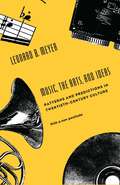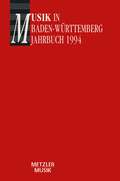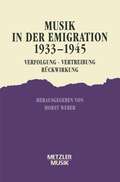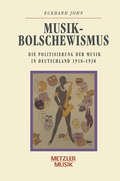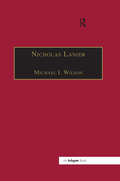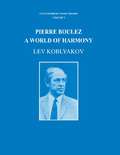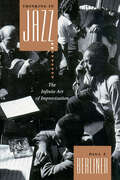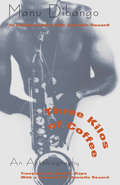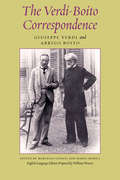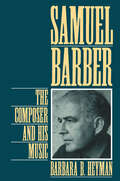- Table View
- List View
Music, the Arts, and Ideas: Patterns and Predictions in Twentieth-Century Culture
by Leonard B. MeyerMeyer makes a valuable statement on aesthetics, criteria for assessing great works of music, compositional practices and theories of the present day, and predictions of the future of Western culture. His postlude, written for the book's twenty-fifth anniversary, looks back at his thoughts on the direction of music in 1967.
Music, the Arts, and Ideas: Patterns and Predictions in Twentieth-Century Culture
by Leonard B. MeyerMeyer makes a valuable statement on aesthetics, criteria for assessing great works of music, compositional practices and theories of the present day, and predictions of the future of Western culture. His postlude, written for the book's twenty-fifth anniversary, looks back at his thoughts on the direction of music in 1967.
Music, the Arts, and Ideas: Patterns and Predictions in Twentieth-Century Culture
by Leonard B. MeyerMeyer makes a valuable statement on aesthetics, criteria for assessing great works of music, compositional practices and theories of the present day, and predictions of the future of Western culture. His postlude, written for the book's twenty-fifth anniversary, looks back at his thoughts on the direction of music in 1967.
Music, the Arts, and Ideas: Patterns and Predictions in Twentieth-Century Culture
by Leonard B. MeyerMeyer makes a valuable statement on aesthetics, criteria for assessing great works of music, compositional practices and theories of the present day, and predictions of the future of Western culture. His postlude, written for the book's twenty-fifth anniversary, looks back at his thoughts on the direction of music in 1967.
Musik in Baden-Württemberg, Band 1: Jahrbuch im Auftrag der Gesellschaft für Musikgeschichte in Baden-Württemberg
by Georg GüntherNicholas Lanier: Master of the King's Musick
by MichaelI. WilsonNicholas Lanier (1588-1666) was not only the first person to hold the office of Master of the Music to King Charles I, he was also a practising painter, a friend of Rubens, Van Dyck and many other artists of his time, and one of the very first great art collectors and connoisseurs. He is especially remembered for the part he played in acquiring, on behalf of Charles I, the famous collection of paintings belonging to the Gonzaga family of Mantua. Many of these paintings still form an important part of the Royal Collection today. In this book the different strands of Lanier's colourful life are for the first time drawn together and presented in a single compelling narrative.
Nicholas Lanier: Master of the King's Musick
by MichaelI. WilsonNicholas Lanier (1588-1666) was not only the first person to hold the office of Master of the Music to King Charles I, he was also a practising painter, a friend of Rubens, Van Dyck and many other artists of his time, and one of the very first great art collectors and connoisseurs. He is especially remembered for the part he played in acquiring, on behalf of Charles I, the famous collection of paintings belonging to the Gonzaga family of Mantua. Many of these paintings still form an important part of the Royal Collection today. In this book the different strands of Lanier's colourful life are for the first time drawn together and presented in a single compelling narrative.
Passport to Jewish Music: Its History, Traditions, and Culture (Contributions to the Study of Music and Dance)
by Irene HeskesThe purpose of this book is to present a survey of Jewish music to illuminate its special role as a mirror of history, tradition, and cultural heritage. The 27 topical chapters have been placed within a modified chronological perspective to present a historic picture of virtually every important development in Jewish music. The book represents a culmination of several decades of the author's dedicated labor and scholarly study in this field.
Paul Creston: A Bio-Bibliography (Bio-Bibliographies in Music)
by Monica J. SlomskiAlthough born Giuseppe Guttovergi to a poor, immigrant Italian family, it was as Paul Creston that Giuseppe rose to prominence, becoming one of the most widely performed American composers. Rhythm was a continued subject of research for this composer, and by 1945 he had established a terminology of rhythmic structures, which he observed both in his music and the music of other composers, even writing two books on the subject. This volume presents for the first time a complete descriptive account of the life of the composer, as well as access to currently available materials by and about him.
Pierre Boulez: A World of Harmony (Contemporary Music Studies #2)
by Lev KoblyakovFirst published in 1994. Routledge is an imprint of Taylor & Francis, an informa company.
Pierre Boulez: A World of Harmony (Contemporary Music Studies)
by Lev KoblyakovFirst published in 1994. Routledge is an imprint of Taylor & Francis, an informa company.
The Popular Song Reader: A Sampler of Well-Known Twentieth-Century Songs
by William E Studwell Frank Hoffmann Beulah B RamirezWho is the Bill Bailey whose exploits were chronicled in song? How many popular songs have titles containing the words “moon,” “heart,” or “baby”? Where is the road to Mandalay? How many female names can you think of that have been mentioned in song titles? Discover this fascinating information and more about some of America's most known and loved popular songs in this delightful sampler. The Popular Song Reader contains over 200 short essays on the backgrounds of a wide variety of twentieth-century American popular songs. The witty and knowledgeable essays touch upon several hundred traditional-style pop songs as well as early rock compositions. The essays are filled with anecdotes, humor, irony, and even poetry that reflect the author's offbeat and somewhat irreverent manner, while also presenting a broad spectrum of American popular songs in their historical and cultural contexts. In addition to information about each song and its composer, the author also discusses how the song reflected society at the time and also how the song itself has influenced popular culture. Pop music fans will find this a highly entertaining and readable guide to the best American popular music of the twentieth century. Divided into five sections, the book covers popular songs from the Tin Pan Alley era (By the Light of the Silvery Moon, California, Here I Come, Let Me Call You Sweetheart, She'll Be Comin’Round the Mountain, and When Irish Eyes are Smiling), the swing/big band era (Don't Get Around Much Anymore, Heart and Soul, In the Mood, Stardust, and Stormy Weather), and the rock era (Chances Are, Good Vibrations, Love Me Tender, Misty, Rock Around the Clock, Stop! In the Name of Love, and The Twist). The Popular Song Reader provides new insights on all-time favorites from Broadway musicals, movies, and television including Ain't Misbehavin', Give My Regards to Broadway, My Funny Valentine, Aquarius, Cabaret, Luck Be a Lady, Mack the Knife, Don't Fence Me In, Over the Rainbow, Singin’in the Rain, and the theme songs from Star Wars , All in the Family, Cheers, and M*A*S*H.
The Popular Song Reader: A Sampler of Well-Known Twentieth-Century Songs
by William E Studwell Frank Hoffmann Beulah B RamirezWho is the Bill Bailey whose exploits were chronicled in song? How many popular songs have titles containing the words “moon,” “heart,” or “baby”? Where is the road to Mandalay? How many female names can you think of that have been mentioned in song titles? Discover this fascinating information and more about some of America's most known and loved popular songs in this delightful sampler. The Popular Song Reader contains over 200 short essays on the backgrounds of a wide variety of twentieth-century American popular songs. The witty and knowledgeable essays touch upon several hundred traditional-style pop songs as well as early rock compositions. The essays are filled with anecdotes, humor, irony, and even poetry that reflect the author's offbeat and somewhat irreverent manner, while also presenting a broad spectrum of American popular songs in their historical and cultural contexts. In addition to information about each song and its composer, the author also discusses how the song reflected society at the time and also how the song itself has influenced popular culture. Pop music fans will find this a highly entertaining and readable guide to the best American popular music of the twentieth century. Divided into five sections, the book covers popular songs from the Tin Pan Alley era (By the Light of the Silvery Moon, California, Here I Come, Let Me Call You Sweetheart, She'll Be Comin’Round the Mountain, and When Irish Eyes are Smiling), the swing/big band era (Don't Get Around Much Anymore, Heart and Soul, In the Mood, Stardust, and Stormy Weather), and the rock era (Chances Are, Good Vibrations, Love Me Tender, Misty, Rock Around the Clock, Stop! In the Name of Love, and The Twist). The Popular Song Reader provides new insights on all-time favorites from Broadway musicals, movies, and television including Ain't Misbehavin', Give My Regards to Broadway, My Funny Valentine, Aquarius, Cabaret, Luck Be a Lady, Mack the Knife, Don't Fence Me In, Over the Rainbow, Singin’in the Rain, and the theme songs from Star Wars , All in the Family, Cheers, and M*A*S*H.
Thinking in Jazz: The Infinite Art of Improvisation (Chicago Studies in Ethnomusicology)
by Paul F. BerlinerA landmark in jazz studies, Thinking in Jazz reveals as never before how musicians, both individually and collectively, learn to improvise. Chronicling leading musicians from their first encounters with jazz to the development of a unique improvisatory voice, Paul Berliner documents the lifetime of preparation that lies behind the skilled improviser's every idea. The product of more than fifteen years of immersion in the jazz world, Thinking in Jazz combines participant observation with detailed musicological analysis, the author's experience as a jazz trumpeter, interpretations of published material by scholars and performers, and, above all, original data from interviews with more than fifty professional musicians: bassists George Duvivier and Rufus Reid; drummers Max Roach, Ronald Shannon Jackson, and Akira Tana; guitarist Emily Remler; pianists Tommy Flanagan and Barry Harris; saxophonists Lou Donaldson, Lee Konitz, and James Moody; trombonist Curtis Fuller; trumpeters Doc Cheatham, Art Farmer, Wynton Marsalis, and Red Rodney; vocalists Carmen Lundy and Vea Williams; and others. Together, the interviews provide insight into the production of jazz by great artists like Betty Carter, Miles Davis, Dizzy Gillespie, Coleman Hawkins, and Charlie Parker. Thinking in Jazz overflows with musical examples from the 1920s to the present, including original transcriptions (keyed to commercial recordings) of collective improvisations by Miles Davis's and John Coltrane's groups. These transcriptions provide additional insight into the structure and creativity of jazz improvisation and represent a remarkable resource for jazz musicians as well as students and educators. Berliner explores the alternative ways—aural, visual, kinetic, verbal, emotional, theoretical, associative—in which these performers conceptualize their music and describes the delicate interplay of soloist and ensemble in collective improvisation. Berliner's skillful integration of data concerning musical development, the rigorous practice and thought artists devote to jazz outside of performance, and the complexities of composing in the moment leads to a new understanding of jazz improvisation as a language, an aesthetic, and a tradition. This unprecedented journey to the heart of the jazz tradition will fascinate and enlighten musicians, musicologists, and jazz fans alike.
Thinking in Jazz: The Infinite Art of Improvisation (Chicago Studies in Ethnomusicology)
by Paul F. BerlinerA landmark in jazz studies, Thinking in Jazz reveals as never before how musicians, both individually and collectively, learn to improvise. Chronicling leading musicians from their first encounters with jazz to the development of a unique improvisatory voice, Paul Berliner documents the lifetime of preparation that lies behind the skilled improviser's every idea. The product of more than fifteen years of immersion in the jazz world, Thinking in Jazz combines participant observation with detailed musicological analysis, the author's experience as a jazz trumpeter, interpretations of published material by scholars and performers, and, above all, original data from interviews with more than fifty professional musicians: bassists George Duvivier and Rufus Reid; drummers Max Roach, Ronald Shannon Jackson, and Akira Tana; guitarist Emily Remler; pianists Tommy Flanagan and Barry Harris; saxophonists Lou Donaldson, Lee Konitz, and James Moody; trombonist Curtis Fuller; trumpeters Doc Cheatham, Art Farmer, Wynton Marsalis, and Red Rodney; vocalists Carmen Lundy and Vea Williams; and others. Together, the interviews provide insight into the production of jazz by great artists like Betty Carter, Miles Davis, Dizzy Gillespie, Coleman Hawkins, and Charlie Parker. Thinking in Jazz overflows with musical examples from the 1920s to the present, including original transcriptions (keyed to commercial recordings) of collective improvisations by Miles Davis's and John Coltrane's groups. These transcriptions provide additional insight into the structure and creativity of jazz improvisation and represent a remarkable resource for jazz musicians as well as students and educators. Berliner explores the alternative ways—aural, visual, kinetic, verbal, emotional, theoretical, associative—in which these performers conceptualize their music and describes the delicate interplay of soloist and ensemble in collective improvisation. Berliner's skillful integration of data concerning musical development, the rigorous practice and thought artists devote to jazz outside of performance, and the complexities of composing in the moment leads to a new understanding of jazz improvisation as a language, an aesthetic, and a tradition. This unprecedented journey to the heart of the jazz tradition will fascinate and enlighten musicians, musicologists, and jazz fans alike.
Thinking in Jazz: The Infinite Art of Improvisation (Chicago Studies in Ethnomusicology)
by Paul F. BerlinerA landmark in jazz studies, Thinking in Jazz reveals as never before how musicians, both individually and collectively, learn to improvise. Chronicling leading musicians from their first encounters with jazz to the development of a unique improvisatory voice, Paul Berliner documents the lifetime of preparation that lies behind the skilled improviser's every idea. The product of more than fifteen years of immersion in the jazz world, Thinking in Jazz combines participant observation with detailed musicological analysis, the author's experience as a jazz trumpeter, interpretations of published material by scholars and performers, and, above all, original data from interviews with more than fifty professional musicians: bassists George Duvivier and Rufus Reid; drummers Max Roach, Ronald Shannon Jackson, and Akira Tana; guitarist Emily Remler; pianists Tommy Flanagan and Barry Harris; saxophonists Lou Donaldson, Lee Konitz, and James Moody; trombonist Curtis Fuller; trumpeters Doc Cheatham, Art Farmer, Wynton Marsalis, and Red Rodney; vocalists Carmen Lundy and Vea Williams; and others. Together, the interviews provide insight into the production of jazz by great artists like Betty Carter, Miles Davis, Dizzy Gillespie, Coleman Hawkins, and Charlie Parker. Thinking in Jazz overflows with musical examples from the 1920s to the present, including original transcriptions (keyed to commercial recordings) of collective improvisations by Miles Davis's and John Coltrane's groups. These transcriptions provide additional insight into the structure and creativity of jazz improvisation and represent a remarkable resource for jazz musicians as well as students and educators. Berliner explores the alternative ways—aural, visual, kinetic, verbal, emotional, theoretical, associative—in which these performers conceptualize their music and describes the delicate interplay of soloist and ensemble in collective improvisation. Berliner's skillful integration of data concerning musical development, the rigorous practice and thought artists devote to jazz outside of performance, and the complexities of composing in the moment leads to a new understanding of jazz improvisation as a language, an aesthetic, and a tradition. This unprecedented journey to the heart of the jazz tradition will fascinate and enlighten musicians, musicologists, and jazz fans alike.
Thinking in Jazz: The Infinite Art of Improvisation (Chicago Studies in Ethnomusicology)
by Paul F. BerlinerA landmark in jazz studies, Thinking in Jazz reveals as never before how musicians, both individually and collectively, learn to improvise. Chronicling leading musicians from their first encounters with jazz to the development of a unique improvisatory voice, Paul Berliner documents the lifetime of preparation that lies behind the skilled improviser's every idea. The product of more than fifteen years of immersion in the jazz world, Thinking in Jazz combines participant observation with detailed musicological analysis, the author's experience as a jazz trumpeter, interpretations of published material by scholars and performers, and, above all, original data from interviews with more than fifty professional musicians: bassists George Duvivier and Rufus Reid; drummers Max Roach, Ronald Shannon Jackson, and Akira Tana; guitarist Emily Remler; pianists Tommy Flanagan and Barry Harris; saxophonists Lou Donaldson, Lee Konitz, and James Moody; trombonist Curtis Fuller; trumpeters Doc Cheatham, Art Farmer, Wynton Marsalis, and Red Rodney; vocalists Carmen Lundy and Vea Williams; and others. Together, the interviews provide insight into the production of jazz by great artists like Betty Carter, Miles Davis, Dizzy Gillespie, Coleman Hawkins, and Charlie Parker. Thinking in Jazz overflows with musical examples from the 1920s to the present, including original transcriptions (keyed to commercial recordings) of collective improvisations by Miles Davis's and John Coltrane's groups. These transcriptions provide additional insight into the structure and creativity of jazz improvisation and represent a remarkable resource for jazz musicians as well as students and educators. Berliner explores the alternative ways—aural, visual, kinetic, verbal, emotional, theoretical, associative—in which these performers conceptualize their music and describes the delicate interplay of soloist and ensemble in collective improvisation. Berliner's skillful integration of data concerning musical development, the rigorous practice and thought artists devote to jazz outside of performance, and the complexities of composing in the moment leads to a new understanding of jazz improvisation as a language, an aesthetic, and a tradition. This unprecedented journey to the heart of the jazz tradition will fascinate and enlighten musicians, musicologists, and jazz fans alike.
Three Kilos of Coffee: An Autobiography (Black Literature And Culture Ser.)
by Manu Dibango Danielle RouardIn 1948, at the age of fifteen, Manu Dibango left Africa for France, bearing three kilos of coffee for his adopted family and little else. This book chronicles Manu Dibango's remarkable rise from his birth in Douala, Cameroon, to his worldwide success—with Soul Makossa in 1972—as the first African musician ever to record a top 40s hit. Composer, producer, performer, film score writer and humanitarian for the poor, Manu Dibango defines the "African sound" of modern world music. He has worked with and influenced such artists as Art Blakey, Don Cherry, Herbie Hancock, Harry Belafonte, Paul Simon, and Johnny Clegg. In Africa, he has helped younger musicians, performed benefit concerts, and transcribed for the first time the scores and lyrics of African musicians. The product of a "mixed marriage" (of different tribes and religions) who owes allegiances to both Africa and Europe, Dibango has always been aware of the ambiguities of his identity. This awareness has informed all of the important events of his life, from his marriage to a white Frenchwoman in 1957, to his creation of an "Afro-music" which joyfully blends blues, jazz, reggae, traditional European and African serenades, highlife, Caribbean and Arabic music. This music addresses the meaning of "Africanness" and what it means to be a Black artist and citizen of the world. This lively and thoughtful memoir is based on an extensive set of interviews in 1989 with French journalist Danielle Rouard. Richly illustrated with photographs, this book will be a must for readers of jazz biographies, students of African music and ethnomusicology, and all those who are lovers of Manu Dibango's unique artistry and accomplishments.
The Verdi-Boito Correspondence
by Arrigo Boito Giuseppe VerdiThese 301 letters between Giuseppe Verdi and his last, most gifted librettist, Arrigo Boito, document an extraordinary chapter in musical history. Now available for the first time in English, this correspondence records both a unique friendship and its creative legacy. This new edition of the landmark Carteggio Verdi/Boito is at once a valuable resource for all students, teachers, and scholars of opera and a fascinating glimpse of the daily life of European art and artists during the fertile last decades of the 19th century. Embarking on a 20-year collaboration, Verdi and Boito produced a successful revision of Simon Boccanegra, and two new operas, Otello and Falstaff. They created what many consider to be Verdi's greatest operas, thanks both to Boito's poetry and to his handling of the composer. Here are the day-to-day tasks of creation: poet and composer debating problems of dramatic structure, words, phrases, and meters; altering dialogue as, at the same time, they converse about the wider worlds of art and music. The give and take of artistic creation is rendered fascinatingly. This edition features a new introduction by Marcello Conati, improvements and updatings to the original edition, and an appendix of undated correspondence. William Weaver's translation is characteristically pitch-perfect; he also provides a short closing sketch of Boito's life after the death of his beloved maestro. Explanatory "linking texts" between the letters create a narrative.
Dancing in Your Head: Jazz, Blues, Rock, and Beyond
by Gene SantoroAs music columnist for The Nation, Gene Santoro has established himself as an important new critical voice, able to write well on a broad spectrum of popular music and jazz without losing touch with the cutting edge of today's music scene. About Nat "King" Cole, Santoro comments: "adjectives can't describe the swinging, ingratiating self-confidence laced with tenderness that colors Nat "King" Cole's singing. His baritone/tenor is so airy and elemental, so palpably physical, it invites you in, then surrounds you glowingly..." And on the highly successful rock band Living Colour, Santoro is no less evocative: "hardcore metal raveups slam into bluesy ballads and psychedelicized pop, lilting Caribbean inflections collide with hiphop scrambles of prerecorded material and touches of funk." Dancing in Your Head gathers Santoro's liveliest reviews and essays for the first time, introducing a fresh and provocative perspective on several decades of musicians and their work. Santoro covers a wide musical vista, from the legendary blues singer Robert Johnson to Public Enemy's controversial rap lyrics, from the long running clash between blues and African American gospel to the rock iconoclast Neil Young, from the great James Brown to George Hay, the founder of the Grand Ole Opry. Documenting the evolution of jazz, rock and roll, and rap, Santoro's observations are incisive, honest, and reflective. Of his early exposure to Jimi Hendrix, John Coltrane and Bela Bartok, Santoro remarks, "That sense of wonder and discovery is what happens when you've been hit by art's immediate vatic power. It has never left me, has been touched and renewed by each encounter I've valued." Santoro examines the staying power of music legends Lou Reed, Eric Clapton, the Grateful Dead, and Sun Ra, the freewheeling jazz artist who prefers to call himself a tone artist rather than a musician. Special highlights include several pieces on Miles Davis; book reviews, including one on Gunther Schuller's two-volume History of Jazz; a lively and detailed profile of the Neville Brothers; and a discussion of jazz great Ornette Coleman that compares him to Orson Welles and Charles Ives. Taken together the pieces in Dancing In Your Head examine the historical roots of today's popular music while offering insight into performers and trends that dominate the current scene. Balancing a critical and historical sensibility with an unharnessed enthusiasm for all forms of music, Santoro is an ideal guide to the old and new.
Samuel Barber: The Composer and His Music
by Barbara B. HeymanSamuel Barber (1910-1981) was one of the most important and honored American composers of the twentieth century. Writing in a great variety of musical forms--symphonies, concertos, operas, vocal music, and chamber music--he infused his works with poetic lyricism and gave tonal language and forms new vitality. His rich legacy includes such famous compositions as the Adagio for Strings, the orchestral song Knoxville: Summer of 1915, three concertos, and his two operas, the Pulitzer Prize-winning Vanessa and Antony and Cleopatra, a commissioned work that opened the new Metropolitan Opera House at Lincoln Center. Generously documented by letters, sketchbooks, original musical manuscripts, and interviews with friends, colleagues and performers with whom he worked, this is the first book to cover Barber's entire career and all of his compositions. The biographical material on Barber is closely interspersed with a discussion of his music, displaying Barber's creative processes at work from his early student compositions to his mature masterpieces. Heyman also provides the social context in which this major composer grew: his education, how he built his career, the evolving musical tastes of American audiences, his relationship to musical giants like Serge Koussevitzky, and the role of radio in the promotion of his music. A testament to the significance of the new Romanticism, Samuel Barber stands as a model biography of an important American musical figure.
